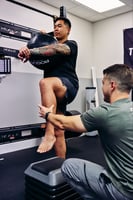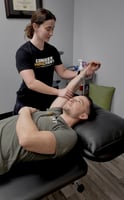Sports injuries can sideline athletes for weeks or even months, impacting both performance and...
Stay in the Game: How Physical Therapy Helps Athletes Thrive from Spring to Summer
The Demands of Seasonal Sports on Athletes
As the weather warms up, athletes transition from winter training into the high-intensity demands of spring and summer sports. Whether it’s baseball, soccer, track and field, or beach volleyball, each sport challenges the body in unique ways. The combination of increased outdoor activity, repetitive motions, and high-impact movements raises the risk of injury, making physical therapy an essential tool for staying in peak condition.
Common Injuries During the Warmer Months
Spring and summer sports often involve explosive movements, rapid changes in direction, and prolonged endurance efforts. These factors contribute to common injuries, including:
- Sprains and Strains: Overstretched or torn ligaments and muscles due to quick pivots and sudden accelerations.
- Tendonitis: Inflammation from repetitive motions, such as swinging a bat, serving a volleyball, or sprinting.
- Stress Fractures: Overuse injuries from repetitive impact, common in runners and jumpers.
- Heat-Related Injuries: Dehydration, cramps, and heat exhaustion become concerns as temperatures rise.
Without proper recovery and conditioning, athletes are more susceptible to these setbacks. Fortunately, physical therapy plays a crucial role in both injury prevention and performance enhancement.
The Role of Physical Therapy in Injury Prevention
Athletes train hard to perform at their best, but without proper injury prevention strategies, they risk setbacks that can take them out of the game. Physical therapy is not just about rehabilitation—it’s a proactive approach to keeping the body strong, mobile, and resilient. By identifying movement imbalances and weaknesses, a physical therapist helps athletes address potential problem areas before they turn into injuries.
How PT Helps Athletes Stay Proactive
One of the biggest advantages of working with a physical therapist is having a customized program that enhances durability and reduces injury risk. Key components include:
- Movement Assessments: Identifying muscle imbalances, poor movement patterns, and joint restrictions that could lead to overuse injuries.
- Strength and Stability Training: Focused exercises to improve core strength, joint stability, and muscular endurance.
- Mobility and Flexibility Work: Optimizing range of motion to prevent strains and stiffness from repetitive athletic movements.
A structured physical therapy program is particularly beneficial for athletes in high-impact and endurance sports, helping them sustain performance throughout the season while minimizing the chances of sidelining injuries.
Recovery and Rehabilitation: Getting Back in the Game
Even with the best prevention strategies, injuries can still happen. When they do, a structured recovery plan is essential for a safe and efficient return to sport. Physical therapy not only helps athletes heal faster but also ensures they regain full strength, mobility, and confidence before stepping back onto the field.
Importance of Proper Rehabilitation
Recovering from an injury isn’t just about resting—it requires guided movement and progressive loading to rebuild strength and function. A well-designed rehab program includes:
- Pain Management Strategies: Techniques such as manual therapy, dry needling, and modalities like ice or heat to reduce inflammation and discomfort.
- Gradual Strengthening Protocols: A progressive plan that restores muscle function without overloading the injured area too soon.
- Neuromuscular Re-Education: Training the body to move efficiently again, improving balance, coordination, and reaction time.
Rushing back too soon or skipping essential rehab steps increases the risk of re-injury. Physical therapists help athletes return to play safely by ensuring they’ve fully recovered and addressing any underlying weaknesses that may have contributed to the injury in the first place.
Performance Enhancement Through Physical Therapy
Physical therapy isn’t just about recovery—it’s also a powerful tool for improving athletic performance. By optimizing movement mechanics, increasing strength, and enhancing endurance, physical therapists help athletes perform at their highest level while reducing strain on the body.
How PT Improves Strength, Endurance, and Agility
Athletes who integrate physical therapy into their training routines gain a competitive edge through:
- Sport-Specific Strength Training: Tailored exercises that target key muscle groups essential for speed, power, and stability.
- Explosive Movement Drills: Plyometrics and agility work to improve reaction time, quickness, and acceleration.
- Endurance Optimization: Techniques that build stamina and efficiency, helping athletes sustain peak performance longer.
By focusing on movement efficiency and injury prevention, physical therapy allows athletes to push their limits while minimizing wear and tear. Whether it’s enhancing sprint mechanics, improving vertical leap, or fine-tuning rotational power, a personalized PT program can make a significant difference in an athlete’s performance.
The Science Behind Injury Recovery and Muscle Adaptation
Understanding how the body heals and adapts is key to optimizing recovery and long-term athletic performance. Physical therapy is rooted in science, using evidence-based techniques to facilitate tissue repair, restore mobility, and enhance overall function.
How the Body Heals with Guided Physical Therapy
When an injury occurs, the body initiates a natural healing process that involves three key phases:
- Inflammation (0-7 days): The body increases blood flow to the injured area, bringing nutrients and immune cells to remove damaged tissue. Physical therapy during this phase focuses on reducing swelling and maintaining mobility without aggravating the injury.
- Repair (1-6 weeks): The body begins rebuilding damaged tissue with collagen fibers, but they are initially weak and disorganized. Controlled movement and progressive strengthening exercises help guide proper tissue remodeling.
- Remodeling (6+ weeks): The repaired tissue strengthens and adapts to load, making it crucial for athletes to gradually reintroduce sport-specific movements under the guidance of a physical therapist.
The Role of Movement Patterns and Biomechanics
In addition to tissue healing, physical therapists analyze an athlete’s movement mechanics to correct inefficiencies that could lead to re-injury. By improving posture, joint alignment, and muscle activation, PT helps athletes move with better efficiency and power while minimizing unnecessary stress on joints and soft tissues.
A well-structured recovery and training program not only restores function but also makes athletes more resilient, allowing them to return to their sport stronger than before.
Why Wilmington, NC Athletes Trust Conquer Movement for Physical Therapy
Athletes in Wilmington, NC, know that staying competitive requires more than just training hard—it requires training smart. At Conquer Movement, we provide specialized physical therapy designed to keep athletes performing at their best while minimizing injury risks. Our hands-on, individualized approach ensures that every athlete receives the care and attention needed to reach their full potential.
Personalized Care and Hands-On Treatment
Unlike generic rehabilitation programs, Conquer Movement tailors each treatment plan to the athlete’s specific sport, injury history, and performance goals. Our approach includes:
- One-on-One Sessions: Focused, hands-on therapy to address pain, mobility restrictions, and movement inefficiencies.
- Advanced Techniques: From dry needling and manual therapy to strength and conditioning, we use cutting-edge methods to accelerate recovery and enhance performance.
- Education and Injury Prevention: We empower athletes with the knowledge and tools to maintain peak condition and prevent future injuries.
Success Stories from Local Athletes
Wilmington’s sports community is filled with athletes who have overcome injuries and improved their performance with the help of Conquer Movement. Whether recovering from a sprained ankle, optimizing running mechanics, or enhancing strength for high-impact sports, our team has helped athletes at every level stay in the game and push their limits.
Tips for Athletes to Stay Healthy and Active All Season
To maintain peak performance and avoid injuries throughout the spring and summer, athletes need to prioritize recovery, conditioning, and overall wellness. Implementing a few key habits can make a significant difference in sustaining strength and endurance while minimizing setbacks.
Key Warm-Ups, Stretches, and Recovery Habits
- Dynamic Warm-Ups: Preparing the body before activity with movement-based stretches like leg swings, arm circles, and lunges to activate muscles and improve mobility.
- Post-Workout Recovery: Incorporating cooldown routines such as foam rolling, static stretching, and mobility drills to enhance flexibility and reduce muscle tightness.
- Rest and Sleep: Ensuring adequate rest between training sessions and prioritizing sleep to allow the body to repair and strengthen muscles.
Hydration, Nutrition, and Lifestyle Factors for Peak Performance
- Stay Hydrated: Warmer temperatures increase the risk of dehydration, so drinking water consistently throughout the day is crucial.
- Fuel for Performance: Eating a balanced diet rich in lean proteins, complex carbs, and healthy fats supports energy levels and muscle recovery.
- Listen to Your Body: Recognizing early signs of fatigue or discomfort and addressing them with physical therapy or rest before they escalate into injuries.
By integrating these strategies into their routine, athletes can maintain optimal performance and longevity in their sport. Physical therapy plays a key role in guiding these habits, ensuring that athletes stay strong, agile, and injury-free throughout the season.
Get Started with Physical Therapy at Conquer Movement
Athletes who want to stay strong, recover faster, and perform at their best need a proactive approach to movement and recovery. At Conquer Movement, we provide expert physical therapy tailored to the demands of your sport, helping you prevent injuries, optimize performance, and get back in the game with confidence.
How to Schedule an Assessment
Starting physical therapy is simple. Whether you're recovering from an injury or looking to enhance your athletic performance, our team is ready to help. Here’s how to get started:
- Book a Consultation: Contact us through our website or call our clinic to schedule an initial assessment.
- Comprehensive Evaluation: Our therapists will assess your movement patterns, strength, and flexibility to create a personalized plan.
- Customized Treatment Plan: Based on your needs, we’ll implement a structured program focused on recovery, injury prevention, and performance enhancement.
What to Expect in Your First PT Session
Your first visit at Conquer Movement will include a thorough evaluation, discussion of your goals, and hands-on treatment to address immediate concerns. Our team will guide you through exercises, manual therapy techniques, and sport-specific movement drills to start your journey toward peak performance.
No matter your sport or skill level, physical therapy can help you stay in top shape and continue doing what you love. Take the next step in your athletic journey by booking an appointment with Conquer Movement today.





Leave A Comment: